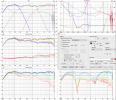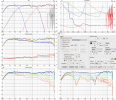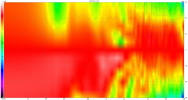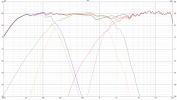If the formulas are used accurately and correctly - the linearity of the frequency band should be less than +/- 1db.
Which simulator are you using?
With Multisim and Orcad - the results are normal. Also with Vituix.
I'm using LTspice, with direct Laplace notation (which I double checked and it is in accordance with your formulas, isn't it?). I get the same result with LSPcad (the "mother" of Vituix), using the Q values provided. The simulators are sure not to blame (I'm using those two for decades now, with no issues, they are always spot on).
But... you show the result using an
LCR realization of those transfer functions, not with the transfer functions directly. I have no doubts that I could recreate your results exactly with LTspice or LSPcad (or Multisim, which I seldom use, though) this way.
Therefore, I would think your derivation of the acoustic target Laplace transfer functions might be off a bit, can you elaborate how you derived the equations or even better, use them as I did, in direct form, to assert that they are valid? For example, there are gain factors in the LCR realization that are not present in the Laplace equations?
Anyhow, this XO faces the typical problem of theses approaches as pointed out by
@ctrl, the broken phase tracking throughout the XO range, leading to significant directivity issues and (almost) destructive summing. And acoustic target function for the tweeter of only 2nd-order is not ideal either. IMHO best used only with beefy Coaxials.
--------:--------
Personally, I've found simple and straight LR4 acoustic target most often sounds best, and tweeter setback can be used there as well (and is implicit in many coaxials anyway) to increase the rolloff for the woofer, practically implementing a Bessel lowpass (aka constant time delay up to some frequency) to compensate the setback to get the acoustic centers aligned again. Exact phase tracking down to at least -30dB for both ways left and right of the XO point is paramount here (much more important than frequency response of the slopes) as that makes the transient behavior (using short narrow-band wavelets/blips) exactly the same for both ways, no "time-smear" widening around the XO.
It then also turns out that making that whole thing linear phase (by doing upstream global phase unwrapping via an
analytically derived FIR filter kernel -- the phase response of the LR4 XO summed allpass function used backwards in time) does not sound much different. Therefore (plus from years of experience), I strongly believe
exact and constant phase tracking between ways -- to whatever target, ususally 0deg but not necessarily for a coaxial or M-T-M, where (up to) 90deg constant offset also does very well and allows for steeper final slopes -- is key for precise and and fast/compact sound signature and good directivity, whereas the overall non-transient-perfect allpass function of the XO is of lesser importance.
Nonwithstanding, I do appreciate your efforts and contributions of course ;-)





